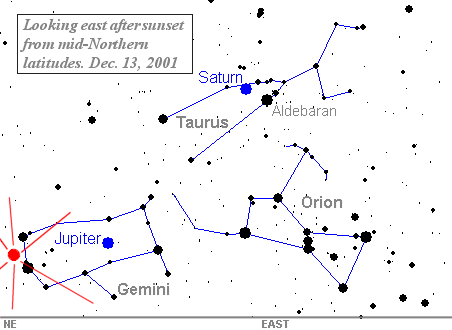Flaring brighter than the full moon, this spectacular Geminid meteor lit up the sky above Cartersville, Ga., at 2:29 a.m. EST on the morning of December 14, 2012. NASA says that this is one of the brightest fireballs observed by the NASA network of meteor cameras in over four years of operation.
The 2012 Geminid Meteor Shower, which peaked on December 13th and 14th, is the most intense meteor shower of the year and can still be seen this week. It lasts for days and can be seen from almost any point on Earth.
The 2012 Geminid meteor shower can be seen around 8 p.m. every evening at the viewer's respective local time. The meteor shower will be the most intense and directly overhead during the hours of 1 a.m. to 3 a.m. The meteor shower sets in the western sky just before sunrise.
A new moon coincides with the 2012 Geminid meteor shower peak. So the dark night sky will make the display even more spectacular.
Geminid meteors stream from a point called "the radiant" in the constellation Gemini.
According to NASA, the Geminids are generally regarded as one of the best annual meteor showers. But before the mid-1800's there were no Geminids, or at least not enough of them to attract attention.

© NASA
The first Geminid shower suddenly appeared in 1862, surprising sky watchers who saw 15 or so shooting stars each hour.
Most meteor showers come from comets, which spew ample meteoroids for a night of 'shooting stars.' The Geminids are different. The parent is not a comet but a weird rocky object named 3200 Phaethon that sheds very little dusty debris - not nearly enough to explain the Geminids.
"Of all the debris streams Earth passes through every year, the Geminids' is by far the most massive," says NASA astronomer Bill Cooke. "When we add up the amount of dust in the Geminid stream, it outweighs other streams by factors of 5 to 500."
3200 Phaethon was discovered in 1983 by NASA's IRAS satellite and promptly classified as an asteroid.
"If 3200 Phaethon broke apart from asteroid Pallas, as some researchers believe, then Geminid meteoroids might be debris from the breakup," speculates Cooke. "But that doesn't agree with other things we know."
Researchers have looked carefully at the orbits of Geminid meteoroids and concluded that they were ejected from 3200 Phaethon when Phaethon was close to the sun -
not when it was out in the asteroid belt breaking up with Pallas. The eccentric orbit of 3200 Phaethon brings it well inside the orbit of Mercury every 1.4 years. The rocky body thus receives a regular blast of solar heating that might boil jets of dust into the Geminid stream.
Source: NASA

Reader Comments
to our Newsletter